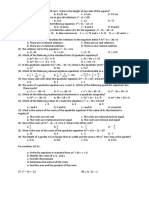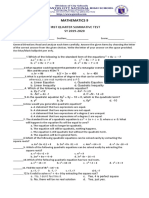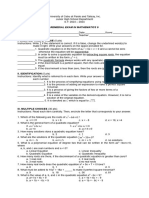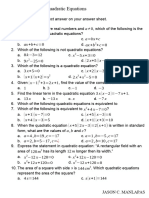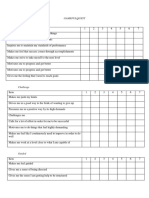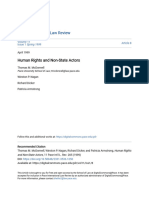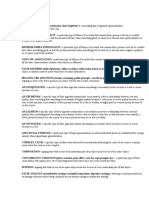0 ratings0% found this document useful (0 votes)
28 viewsq1 Modular Exam
q1 Modular Exam
Uploaded by
Magbanua Jaycee PieriThe document is a practice exam for a modular exam on quadratic equations. It contains 30 multiple choice questions testing various concepts related to quadratic equations, including: identifying quadratic equations; determining values of a, b, and c in standard form equations; finding roots; determining the nature of roots based on the discriminant; and solving word problems involving quadratic equations. It also contains several problems involving rational equations and their transformation into quadratic equations using techniques like the least common multiple.
Copyright:
© All Rights Reserved
Available Formats
Download as DOCX, PDF, TXT or read online from Scribd
q1 Modular Exam
q1 Modular Exam
Uploaded by
Magbanua Jaycee Pieri0 ratings0% found this document useful (0 votes)
28 views2 pagesThe document is a practice exam for a modular exam on quadratic equations. It contains 30 multiple choice questions testing various concepts related to quadratic equations, including: identifying quadratic equations; determining values of a, b, and c in standard form equations; finding roots; determining the nature of roots based on the discriminant; and solving word problems involving quadratic equations. It also contains several problems involving rational equations and their transformation into quadratic equations using techniques like the least common multiple.
Original Title
q1 modular exam.docx
Copyright
© © All Rights Reserved
Available Formats
DOCX, PDF, TXT or read online from Scribd
Share this document
Did you find this document useful?
Is this content inappropriate?
The document is a practice exam for a modular exam on quadratic equations. It contains 30 multiple choice questions testing various concepts related to quadratic equations, including: identifying quadratic equations; determining values of a, b, and c in standard form equations; finding roots; determining the nature of roots based on the discriminant; and solving word problems involving quadratic equations. It also contains several problems involving rational equations and their transformation into quadratic equations using techniques like the least common multiple.
Copyright:
© All Rights Reserved
Available Formats
Download as DOCX, PDF, TXT or read online from Scribd
Download as docx, pdf, or txt
0 ratings0% found this document useful (0 votes)
28 views2 pagesq1 Modular Exam
q1 Modular Exam
Uploaded by
Magbanua Jaycee PieriThe document is a practice exam for a modular exam on quadratic equations. It contains 30 multiple choice questions testing various concepts related to quadratic equations, including: identifying quadratic equations; determining values of a, b, and c in standard form equations; finding roots; determining the nature of roots based on the discriminant; and solving word problems involving quadratic equations. It also contains several problems involving rational equations and their transformation into quadratic equations using techniques like the least common multiple.
Copyright:
© All Rights Reserved
Available Formats
Download as DOCX, PDF, TXT or read online from Scribd
Download as docx, pdf, or txt
You are on page 1of 2
OSNHS Q1 Modular Exam 18.
A PERFECT SQUARE _______ is a product of a
Name:________________________________________ SQUARE OF BINOMIAL
Date:_______________________ Year & Sec:________ a) Monomial c) Polynomial
Directions: Encircle the letter of the correct answer. b) Trinomial d) Quadnomial
1. Which of the following is not a quadratic equation? 19-21 Determine a number (n) that must be added to
a) 4x – 7 = x 2 c) (3x – 9)(2x+3) = 0 make each of the following a PERFECT SQUARE
2
b) 5 x −10=0 d) x + 10 = 0 TRINOMIAL
2. Which of the following is a quadratic equation? 19. x 2 + 8x + ________
a) X + 2 = 0 c) (x+1)(x+2) = 0 a) 14 b) 15 c) 16 d) 17
b) x + 2xy -y = 0 d) x – 5 = 0 20. r 2 – 20r + ________
3. It is an algebraic equation of degree 2 (meaning a) 80 b) 90 c) 70 d) 100
the highest exponent for the variable “x” is 2). 21. The nature of the roots of quadratic equation can be
a) Linear Equation c) Cubic Equation determined by the _______.
b) Quadratic Equation d) Polynomial a. Discriminant b. Quadrant c. Trinomial d. Zero
4. Which of the following is the value of a in the 22. If the discriminant is ___, the roots are real, rational
following equation x 2−12 x−3=0 ? and equal.
a. 1 b.0 c.2 d.-1
a) 1 b) -12 c)-3 d) 0
23. If the discriminant is _____ and a perfect square,
5. Which of the following is the value of b in the
then the roots are real, rational and unequal.
following equation x 2+ 4 x−2=0
a. Negative b. Zero c. Positive d. Equal
a) 4 b) 1 c) -2 d) 0
24. If the discriminant is _______, then the roots are
6. Which of the following is the value of C in the
not real or imaginary.
following equation x 2−12 x−3=0 ? a. Positive b. Zero c. Equal d. Negative
a) 1 b) -3 c) 3 d) -12 25. If the discriminant is POSITIVE and not a perfect
7. Which of the following is an example of a perfect square, then the roots are unequal and ______.
square? a. Irrational b. rational c. real d. imaginary
a) 5 b) 7 c) 9 d) 11 26. Describe the nature of the roots of the quadratic
8. what is the square root of 64? equation x 2−4 x+ 4=0
a) 1 b) 2 c) 4 d) 8
a. real, irrational & equal c. real, rational & unequal
9. what are the roots of x 2 – 49 = 0? b. real, rational & equal d. real, irrational & unequal
a) x1=7, x2=-7 c) x1=4, x2=9 27. Describe the nature of the roots of the quadratic
b) x1=7, x2=9 d) x1=9, x2=-7 equation x 2+ 7 x +10=0
10. Which of the following is not a factor of 20?
a. real, irrational & equal c. real, rational & unequal
a) 4&5 b) 3&10 c)20&1 d)2&10
b. real, rational & equal d. real, irrational & unequal
11. What are the factors of 49?
28. Describe the nature of the roots of the quadratic
a) 4&9 b) 9&7 c)7&7 d)5&6
equation 3 x 2+2 x +2=0
12. What are the factors of 18?
a. real, irrational & equal c. real, rational & unequal
a) 1&18 b) 2&9 c)6&3 d) all of these
b. real, rational & equal d. not real or imaginary
13. Solve for the roots of 3 x 2 + 8x + 4 = 0.
29. Describe the nature of the roots of the quadratic
a) 2, 2/3 b) 3, 2/3 c) -2, 3/2 d) -2/3, -2
equation x 2+ 2 x−5=0
14. Solve for the roots of 4 x 2 + 12x = 7.
a. real, irrational & equal c. real, rational & unequal
a) ½ & 2/7 b) ½ & 3/7 c) ½ & -7/2 d) -1/2 & 7/2
b. real, rational & equal d. real, irrational & unequal
15. solve for the roots of 2 x 2−5 x−12=0 . 30. Which of the following is the formula of
a) 4, 2/3 b) 4, -3/2 c) 2/3, 3/2 d) -2/3, 2 Discriminant?
16. Solve the length of a rectangle is 6 cm more than
a. D = √ b2−4 ac c. D = b 2−4 ac
the width. If the area is 55 cm2, find the dimensions of
the rectangle. b. D = b 2+ 4 ac d. D = √ b2 + 4 ac
a) w=5cm, L=11cm c) w=11cm, L=5cm 31. Some RATIONAL EQUATIONS can be transformed
b) w=6cm, L=5cm d) w=6cm, L=11cm into a Quadratic Equations by using the ___________
17. Solve for one positive number exceeds another by 5. a. LCD b. LCM c. Factoring d. Discriminant
The sum of their squares is 193. Find both numbers. 32. Find the LCM of the rational expression 3x/4 & 5/6
a) 7&12 b) 6&11 c)5&10 d)4&9 a. 12 b. 2 c. 6 d. 4
33. Transform x(x – 5) = 36 into standard form
a. 2x – 5x -36 = 0 c. x – 5x + 36 = 0
2
b. x −10 x−36=0 d. x 2−5 x−36=0
34. Solve for the roots of x(x + 9) + 36 = 0
a. 2&4 b. 3&6 c. 3&12 d. 6&12
35. Solve for the roots of ¿ = 64.
a. -2&8 b. -2&14 c. -2&4 d. -2&10
36. Give the formula of Rate of work done together.
a. (RTOGETHER) = (RA) + (RB) c. (RTOGETHER) = (RA) -
(RB)
b. (RTOGETHER) = 2(RA) - (RB) d. (RTOGETHER) = (RA)
(RB)
Problem-Solving involving rational algebraic equations
37-38 Jessie and Mark are planning to paint a house
together. Jessie thinks it would take him 5 hours MORE
THAN the time Mark takes to paint the entire house
alone. Working together, they can complete the job in 6
hours.
37. How long would it take for Mark to paint the house
alone?
a. Mark can finish painting the house alone in 3 hours.
b. Mark can finish painting the house alone in 5 hours.
c. Mark can finish painting the house alone in 8 hours.
d. Mark can finish painting the house alone in 10 hours
38. How about JESSIE?
a. Jessie can finish the job alone in 10 hours
b. Jessie can finish the job alone in 13 hours
c. Jessie can finish the job alone in 15 hours
d. Jessie can finish the job alone in 18 hours
39-40 The sum of an integer and twice its reciprocal is
equal to 19/3.
39. what formula is applicable to the problem?
a. Discriminant c. Factoring
b. Quadratic d. Pythagorean Theorem
40. What is the number?
a. 4 b. 6 c. 8 d. 10
You might also like
- Pharma Marketing Management (Thakur Publication)Document297 pagesPharma Marketing Management (Thakur Publication)jaiswalmaya630100% (2)
- 1000 Edu Backlinks ListDocument68 pages1000 Edu Backlinks ListSasi Kumar100% (3)
- ATI TEAS Calculation Workbook: 300 Questions to Prepare for the TEAS (2024 Edition)From EverandATI TEAS Calculation Workbook: 300 Questions to Prepare for the TEAS (2024 Edition)No ratings yet
- Grade 9 Math Exam 1st FINALDocument4 pagesGrade 9 Math Exam 1st FINALBill Villon50% (2)
- The Heath SB-400: Ci Escr IptionDocument2 pagesThe Heath SB-400: Ci Escr IptionRafael Suarez100% (1)
- Testing and CalibrationDocument36 pagesTesting and CalibrationBruno FurukawaNo ratings yet
- Atpl - Exim Solution 2018Document23 pagesAtpl - Exim Solution 2018Mehul BazariaNo ratings yet
- Math 9Document2 pagesMath 9Susan LorsanoNo ratings yet
- Pretest Math9Document3 pagesPretest Math9arlene ucolNo ratings yet
- First-Quarter-Final-Math 9 2021Document3 pagesFirst-Quarter-Final-Math 9 2021Angela RuleteNo ratings yet
- Mathematics 9 First Quarter ExamDocument4 pagesMathematics 9 First Quarter ExamMayang Robete100% (1)
- 1st Periodical Tes SY 22 23Document3 pages1st Periodical Tes SY 22 23Jeraldine CuetoNo ratings yet
- 1stQ-G9-Math-slight-revision (AutoRecovered)Document4 pages1stQ-G9-Math-slight-revision (AutoRecovered)Benjie VillafloresNo ratings yet
- Q1 Math 9Document2 pagesQ1 Math 9Rosalyn Cabual100% (1)
- First Grading Exam 9 1Document2 pagesFirst Grading Exam 9 1Vherna May Delos SantosNo ratings yet
- 1st Quarterly Test in Mathematics StudentsDocument7 pages1st Quarterly Test in Mathematics StudentsIrish Rhea FamodulanNo ratings yet
- First Quarter Examination Grade 9Document6 pagesFirst Quarter Examination Grade 9MARTIN, PRINCE YVAN L.No ratings yet
- Grade 9 RemedialDocument2 pagesGrade 9 RemedialIrene Mae Belda100% (1)
- GRADE - 9 - Mathematics - 1st Quarterly ExaminationDocument6 pagesGRADE - 9 - Mathematics - 1st Quarterly ExaminationBenjie VillafloresNo ratings yet
- 2nd Examination G9Document2 pages2nd Examination G9Wil-Anne GarciaNo ratings yet
- Multiple Choice: Write The Letter of The Correct Answer Before Each Number. Ax + BX + C 0Document5 pagesMultiple Choice: Write The Letter of The Correct Answer Before Each Number. Ax + BX + C 0regor velascoNo ratings yet
- 1st Quarterly Examination Math 9Document4 pages1st Quarterly Examination Math 9Rommel FranciscoNo ratings yet
- First Periodic Examination Mathematics - Grade 9 School Year 2019 - 2020Document4 pagesFirst Periodic Examination Mathematics - Grade 9 School Year 2019 - 2020Cecil James Velasco100% (2)
- Validation Test Q1-Cycle 1 Math 9 For StudentsDocument3 pagesValidation Test Q1-Cycle 1 Math 9 For StudentsRasty JunioNo ratings yet
- Grade 9 Pre TestDocument3 pagesGrade 9 Pre TestChelsie May ReyesNo ratings yet
- 1st P.exm Math9Document3 pages1st P.exm Math9SALLY PEROCHENo ratings yet
- Top 100 MCQs Math Class 10Document21 pagesTop 100 MCQs Math Class 10Sai RajendarNo ratings yet
- First Quarter Long Test in Math 9Document3 pagesFirst Quarter Long Test in Math 9FRANCESCA RIA MARIANONo ratings yet
- 1st Quarter Math 9Document4 pages1st Quarter Math 9Joven Oribe Rivas, LPTNo ratings yet
- Ist Q Math 9Document2 pagesIst Q Math 9stephane joy tagayong100% (1)
- MATHEMATICS 9 1st Grading Summative 2019-2020Document5 pagesMATHEMATICS 9 1st Grading Summative 2019-2020Sheena Marie Lonzon100% (2)
- Math 9 1st PeriodicalTest With Key Answers 2022 2023Document4 pagesMath 9 1st PeriodicalTest With Key Answers 2022 2023Jm DabuNo ratings yet
- math 9 1st quarter examDocument2 pagesmath 9 1st quarter examcloudine.cosNo ratings yet
- 1st Quarter Summative Exam Grade 9 MathematicsDocument3 pages1st Quarter Summative Exam Grade 9 MathematicsVienna MendozaNo ratings yet
- Grade 9 RemedialDocument2 pagesGrade 9 RemedialIrene Mae BeldaNo ratings yet
- Math 9Document2 pagesMath 9wendang0202No ratings yet
- 1st Periodical TestDocument4 pages1st Periodical TestFateNo ratings yet
- Chapter Test For Quadratic Equation and Inequality 1Document4 pagesChapter Test For Quadratic Equation and Inequality 1xanderakkangNo ratings yet
- RM9 C1 ChapterReview GREENDocument5 pagesRM9 C1 ChapterReview GREENcheena amazonNo ratings yet
- 1st Grading TestDocument3 pages1st Grading Testjonessamaranga100No ratings yet
- Math 9 1st Summative Test FinalDocument5 pagesMath 9 1st Summative Test FinalMariel PastoleroNo ratings yet
- 1st Qe Math 9Document3 pages1st Qe Math 9agbulalaine088No ratings yet
- Q1 Math-9-Actual ExamDocument3 pagesQ1 Math-9-Actual ExamMarrie Anne Buena-Agua MercaNo ratings yet
- G-10 Math Preboard Paper-IDocument7 pagesG-10 Math Preboard Paper-ILeela MadhuriNo ratings yet
- Multiple Choice: Write The Letter of The Correct Answer Before The NumberDocument5 pagesMultiple Choice: Write The Letter of The Correct Answer Before The Numberregor velascoNo ratings yet
- Demo (Direct Variation)Document4 pagesDemo (Direct Variation)Catherine FadriquelanNo ratings yet
- XI SCI HYE NTIS 24Document6 pagesXI SCI HYE NTIS 24moutushidharghoshNo ratings yet
- Final FINAL Exam Math (Repaired)Document3 pagesFinal FINAL Exam Math (Repaired)Dyna Rose Dosano PeñolNo ratings yet
- Final Exam MathDocument3 pagesFinal Exam MathDyna Rose Dosano PeñolNo ratings yet
- 1ST Quarter Exam Math 9 2022Document4 pages1ST Quarter Exam Math 9 2022liomer credoNo ratings yet
- Grade 8 and Grade 9 1st Quater ExamDocument12 pagesGrade 8 and Grade 9 1st Quater ExamJanus flor BelloNo ratings yet
- Q1 MATH 9 SET CDocument2 pagesQ1 MATH 9 SET CMariel PastoleroNo ratings yet
- Mathematics 9Document8 pagesMathematics 9ellton john pilarNo ratings yet
- Math Final Answer KeyDocument3 pagesMath Final Answer KeyVernaMae Caballero BaylocesNo ratings yet
- 1st Periodic Test - Math 9Document3 pages1st Periodic Test - Math 9RichardRaquenoNo ratings yet
- 2006Document4 pages2006Jubeth PalerNo ratings yet
- Grade 9 - 1st Periodic TestDocument6 pagesGrade 9 - 1st Periodic TestJaninne Villa del ReyNo ratings yet
- Math Final ExamDocument4 pagesMath Final ExamLean LeanNo ratings yet
- 1st MASTERY EXAM IN MATH 9Document7 pages1st MASTERY EXAM IN MATH 9Alfred Intong100% (1)
- Quadratic EquationsDocument7 pagesQuadratic EquationsJason Cortes ManlapasNo ratings yet
- 1st Periodic Test in Math 9Document4 pages1st Periodic Test in Math 9MarlaFirmalino100% (2)
- Q1 MATH 9 SET ADocument2 pagesQ1 MATH 9 SET AMariel PastoleroNo ratings yet
- Math 9 Exam 1st Quarter 2016-2017Document2 pagesMath 9 Exam 1st Quarter 2016-2017Jessemar Solante Jaron Wao100% (2)
- Trigonometric Ratios to Transformations (Trigonometry) Mathematics E-Book For Public ExamsFrom EverandTrigonometric Ratios to Transformations (Trigonometry) Mathematics E-Book For Public ExamsRating: 5 out of 5 stars5/5 (1)
- Coleman Montana 6Document2 pagesColeman Montana 6WalterNo ratings yet
- Unveiling The Lived Sexual Self EthnosemDocument33 pagesUnveiling The Lived Sexual Self EthnosemあきとーえいとNo ratings yet
- If t7 1 PPTX Agitacion y Mezcla PDFDocument43 pagesIf t7 1 PPTX Agitacion y Mezcla PDFHugo de la FuenteNo ratings yet
- Game Ful QuestDocument3 pagesGame Ful QuestMaria HassanNo ratings yet
- Flow and Mindfulness (1)Document18 pagesFlow and Mindfulness (1)PoulomiNo ratings yet
- DELD - QuestionBank Unit 3 4 5 6Document4 pagesDELD - QuestionBank Unit 3 4 5 6hetavimodi2005No ratings yet
- Human Rights and Non-State ActorsDocument55 pagesHuman Rights and Non-State Actorskassahun argawNo ratings yet
- BC Hydro - Wilder Creek Fish Habitat PlanDocument11 pagesBC Hydro - Wilder Creek Fish Habitat PlanAlaskaHighwayNewsNo ratings yet
- AnalyticalMethod 210114+nakDocument30 pagesAnalyticalMethod 210114+nakAung MwinNo ratings yet
- MMC Barriers in IMC-Nikita JaswaneyDocument13 pagesMMC Barriers in IMC-Nikita JaswaneyNikita JaswaneyNo ratings yet
- Gateway B1+ Final Review Test ADocument5 pagesGateway B1+ Final Review Test AKids Challenge100% (1)
- Concrete Mix Design For - M5: (As Per IS 10262-2019)Document8 pagesConcrete Mix Design For - M5: (As Per IS 10262-2019)mahesh naik100% (1)
- Energy and Buildings: Y.H. Yau, H.L. PeanDocument7 pagesEnergy and Buildings: Y.H. Yau, H.L. PeanAhmad AnsariNo ratings yet
- Jan 2022 MSDocument16 pagesJan 2022 MSAlia MohamedAmin MemonNo ratings yet
- PaugDocument1,471 pagesPaugMohammed IzaqNo ratings yet
- Science - Stage 5 - 02 - 8RP - AFP - tcm142-640011Document16 pagesScience - Stage 5 - 02 - 8RP - AFP - tcm142-640011Abeer Elgamal100% (2)
- Engaging The Community Through ALSDocument20 pagesEngaging The Community Through ALSLG BaganiNo ratings yet
- BSA Radio CommunicationsDocument6 pagesBSA Radio CommunicationsS. CarterNo ratings yet
- DS XPR-S Comparators enDocument2 pagesDS XPR-S Comparators enFarida NurNo ratings yet
- SkillsDocument3 pagesSkillseiad ahmedNo ratings yet
- Performance Test of A Shock AbsorberDocument3 pagesPerformance Test of A Shock AbsorberRaja SekaranNo ratings yet
- Electromagnetic Wave Equations Learning GuideDocument4 pagesElectromagnetic Wave Equations Learning GuideKate Megan ApuliNo ratings yet
- Common FallaciesDocument4 pagesCommon FallaciesAnne CasualNo ratings yet
- Delivery Advice: For The DealerDocument3 pagesDelivery Advice: For The Dealersanjay bindNo ratings yet
- Beyond Boundaries - Huawei MatePad Pro 13.2-Inch, MateBook D 16 2024, and FreeClip Raise The Bar For Portable Innovation and Creative MasteryDocument4 pagesBeyond Boundaries - Huawei MatePad Pro 13.2-Inch, MateBook D 16 2024, and FreeClip Raise The Bar For Portable Innovation and Creative MasteryAlora Uy GuerreroNo ratings yet







